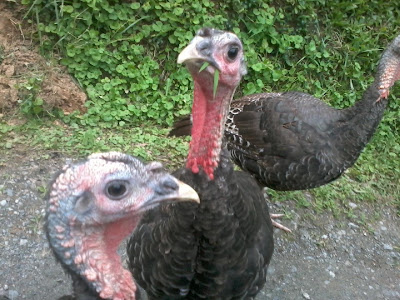Days in the garden are marked by the routine visits of 18 wild turkeys. Two hens are showing the ropes to 16 half growns. They waddle from one wooded bank of the cove, forage in my dang gui, bo he and buckwheat for long enough to scratch up freshly spread wheat straw mulch and nibble insects and what nots, and then they disappear into the deep, thick green. Their feeding here causes occasional minor damage and annoyance but is enjoyed overall.
If I am out and about in the holler at dark, I am lucky to experience the bizarre range of vocal capacities of the Eastern screech owls. Sometimes they sound like human babies, sometimes like cats, sometimes like aliens, and sometimes just like owls. About a month ago, Susie, Kristen and I watched one fly back and forth across Kristen's yard, perching in low branches between flights. It allowed me to approach closely as it sat and watched from a sumac. Brilliant clay reddish brown. I don't know what sex.
Due to the July 1 flood, Guntertown Rd is still closed as half of it broke off and washed down 100 feet of steep mountain. The detour has me communting to Hot Springs many mornings by way of Cedar Cliff, which is much more pastoral than this wooded dingle where I reside. Often I will encounter interesting bird activity as I slowly cruise the one lane gravel windy road. A cooper's hawk snatching a morning dove and the subsequent commotion. A pair of bobwhites (trying to make their Cedar Cliff comeback from a recent decline) crossing the road hurredly. A trio of curious domestic turkeys begging the truck for tasty morsels.
************************
The pair of young yellow shafted flickers that Pete D. showed me last week in a fence post nest has probably fledged.
*************************
The osprey who lives on the Laurel between the old Gahagan house and Belva is thriving, healthy and gorgeous. I saw it the other morning (sex undetermined) with a freshly killed 12-ish inch long trout. I stopped the car to get a good look, and the osprey vocalized at me with raptoral gusto- first a series of high pitched emphatic whines, then some low, gutteral grunts. It grasped that trout tightly with large talons.
****************************************
Other summer bird highlights:
Good One: I got to see a kingfisher (likely young and in training) up very close earlier in the summer. It was sitting on the ground between the road and the Laurel River, a little down stream from this ospry photo. I approached it almost close enough to touch it. Another kingfisher flew overhead, vocalizing and perched on a wire. Finally the one on the ground flew up toward the other one. They are beautiful birds. Maybe next year I'll go kingfisher nest hunting- they burrow in high river banks to nest!
Bad One: I watched a nest of wrens fledge from Susie and Todd's porch. One of the fledglings got caught by their cat, and I immediately intervened (I'm on the bird's side- hands down- can't help it). The bird was unharmed by the cat, but had holes all in its head that maggots were boring their way out of. I held the bird for about 10 minutes, observing the head because I had never seen anything like it. The skin of the head was wiggling with the sub-q movement of maggots, and in that amount of time I watched 7 maggots work their way out of the tiny wren head. It was disgusting. I don't know how on earth the bird was still alive, and I wished I had let the cat kill it. I let the bird fledge again, and hoped for its quick painless death by predator. Jeez. Perhaps it was a result of the moist, maggoty summer we've had.
I hate to end on a gross note so here's one last Good Bird Highlight of the summer: I watched black and turkey vultures soar above Hot Springs, and reviewed some of the differing characteristics of each. For your vulture identifying ease:
Black Vultures: short tail; dark with white patches near wing tip when in flight; smaller and shorter wingspan than turkey vultures, flaps wings more in flight. Also, "Black Vulture has heavier wingloading than Turkey Vulture, requiring stronger thermals for soaring, so usually becomes active an hour or more after Turkey Vulture." (quoted from Black Vulture species handout sheets from a course I took called Natural History of Southern Raptors at the Carolina Raptor Center in 1995.)
Turkey Vultures: most common American vulture; wings narrower than black vulture; in flight wings held in a slight V shape; tail is long; adult's head is small and reddish; soars on thermals; sways and rocks from side to side during flight.



No comments:
Post a Comment